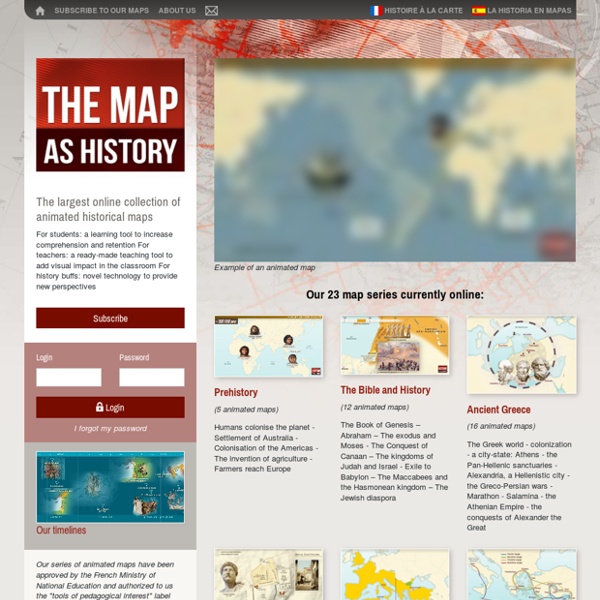



https://www.the-map-as-history.com/
Related: history • Geography • History • World • HistoriaWhy Don’t We All Speak the Same Language? (Earth 2.0 Series) Linguists predict that some 3,000 languages spoken will go extinct within the next century. (Photo: Paul Stevenson/Flickr) Our latest Freakonomics Radio episode is called “Why Don’t We All Speak the Same Language? (Earth 2.0 Series).”
An Introduction to 100 Important Paintings with Videos Created by Smarthistory If you have an interest in how the internet has widened the very concept of education, you may well know about Google's Art Project, a digital wealth of free visual art information and viewing opportunities we've featured before. And you more than likely know about Khan Academy, the highest-profile producer of educational videos on the internet. Now, from the combined power of their learning resources comes this collection of video introductions to over 100 important paintings. Ranging from between two to nine minutes and covering works of art created in eras from 575 B.C.E to the Second World War, these brief but intellectually dense and visually rich lessons bear the label of Smarthistory, "a multimedia web-book about art and art history" that merged with Khan Academy in 2011.
Sumerian Mythology FAQ by Christopher Siren, 1992, 1994, 2000 cbsiren at alum dot mit dot edu This FAQ used to be posted on the third of every month to alt.mythology. Internet History Sourcebooks Internet Modern History Sourcebook The Internet Modern History Sourcebook now contains thousands of sources and the previous index pages were so large that they were crashing many browsers. See Introduction for an explanation of the Sourcebook's goals. Explanation of Sources of Material Here.
SPS Projects: Global Issues, 7th Grade Social Studies Contributing Teacher: Shawn Thomas Name of Project: Global Issues Content Area: 7th Grade Social Studies District Goal Strategies Used: An open ended question that requires students to think critically about an engaging topicMultiple pathways to demonstrate learningOpportunities for students to share their thinking and collaborate with othersWork shared with an audience beyond the teacher and the classroomTechnology integration that enhances learning at the Modification and/or Redefinition level (SAMR) Project Description: Top 10 Toilets Through Time It’s not glamorous, but everybody needs to do it. From Romans gossiping on the loo to medieval royal bottom-wiping, to the invention of our modern flushing toilet, here are 2,000 years of toilet history! *Updated November 2017*
The Early Middle Ages, 284–1000 Professor Paul Freedman, Chester D. Tripp Professor of History Description Major developments in the political, social, and religious history of Western Europe from the accession of Diocletian to the feudal transformation.
Internet History Sourcebooks Project East Asian History Sourcebook There is no way of avoiding the fact that China is the central culture of Eastern Asia. Massively larger than any of her neighbors, China may have developed its cultural forms in relative isolation, but since the advent of Buddhism has both absorbed outside influences and disseminated its own culture. Japanese, Korean and Vietnamese cultures are not comprehensible without taking into account power of Chinese culture in art, literature and religion. Chinese culture itself is highly complex, and the other East Asian cultures also reflect local circumstances and traditions. For instance the (later) Chinese ideal of a scholar-gentleman contrasts strongly with Japanese warrior ideals.
The Source of the Mekong - A River's Tail After more than a year and half of following the Mekong through four countries, we end our journey more than five kilometres higher and nearly 5000km away from where we started at the South China Sea. Writing and Colour Photographs by Luc Forsyth, Black and White Photographs by Gareth Bright, Videography by Pablo Chavanel. About the authors It wasn’t until we turned off the paved highway and onto a roughly graded dirt road that the reality of finishing our project began to set in. For more than a year and a half we had been following the Mekong and it had become something of a compulsion. It was no longer something we were consciously aware of but rather it seemed like an instinct, like something we had always done and would always do.